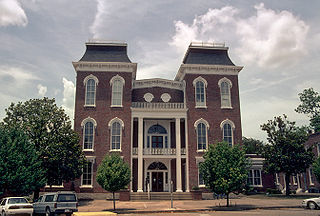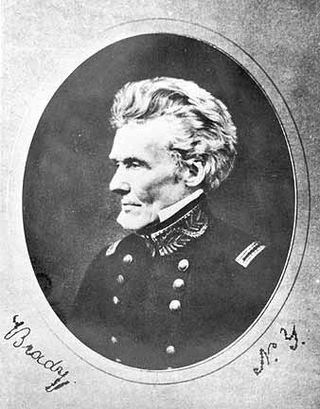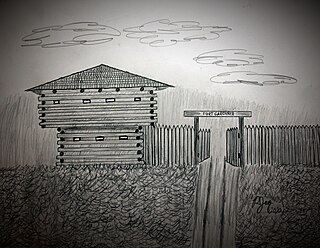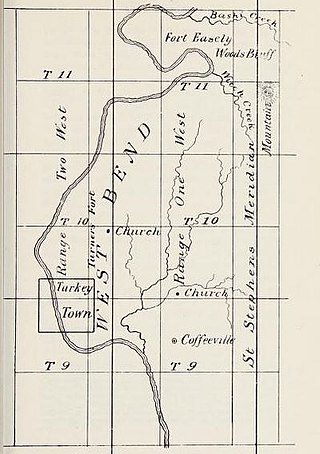Related Research Articles

Bullock County is a county of the U.S. state of Alabama. As of the 2020 census, the population was 10,357. Union Springs was chosen as the county seat in 1867, and presently is the county's only incorporated city. The county was named for Confederate Army Colonel Edward C. Bullock who was a state senator and outspoken secessionist who died during the American Civil War.

The Creek War, was a regional conflict between opposing Native American factions, European powers, and the United States during the early 19th century. The Creek War began as a conflict within the tribes of the Muscogee, but the United States quickly became involved. British traders and Spanish colonial officials in Florida supplied the Red Sticks with weapons and equipment due to their shared interest in preventing the expansion of the United States into regions under their control.

The Territory of Mississippi was an organized incorporated territory of the United States that was created under an organic act signed into law by President John Adams on April 7, 1798, and was dissolved on December 10, 1817, when the western half of the territory was admitted to the Union as the State of Mississippi. The eastern half was redesignated as the Alabama Territory until it was admitted to the Union as the State of Alabama on December 14, 1819. The Chattahoochee River played a significant role in the definition of the territory's borders. The population rose in the early 1800s from settlement, with cotton being an important cash crop.

Edmund Pendleton Gaines was a career United States Army officer who served for nearly fifty years, and attained the rank of major general by brevet. He was one of the Army's senior commanders during its formative years in the early to mid-1800s, and was a veteran of the War of 1812, Seminole Wars, Black Hawk War, and Mexican–American War.

Thomas Sidney Jesup was a United States Army officer known as the "Father of the Modern Quartermaster Corps". His 52-year (1808–1860) military career was one of the longest in the history of the United States Army.
Gilbert Christian Russell was an American military officer who served during the Creek War. Born in Virginia, Russell moved to Alabama as a young man. In 1809, Russell was serving as commandant of Fort Pickering when Meriwether Lewis spent two weeks there on his trip to Washington, D.C. Russell and Lewis became friends, and Russell attempted to accompany Lewis on the remainder of his journey but Russell's superiors denied his request. During the Creek War, he was the commander of the 3rd U.S. Infantry Regiment of the United States Army. His soldiers reinforced General Ferdinand Claiborne at Fort Claiborne and on December 13, 1813, the combined forces launched an invasion at the core of the Creek Nation which culminated in a victory over the Creek at the Battle of Holy Ground. After the Battle of Holy Ground, Russell planned an unsuccessful attack on Red Stick villages located on the Cahaba River. After the Battle of Horseshoe Bend, Russell and the 3rd Infantry were transferred from Fort Claiborne to Fort Jackson. Russell County, Alabama was named in his honor.

The Battle of Holy Ground, or Battle of Econochaca, was a battle fought on December 23, 1813, between the United States militia and the Red Stick Creek Indians during the Creek War. The battle took place at Econochaca, the site of a fortified encampment established in the summer of 1813 by Josiah Francis on a bluff above the Alabama River, in what is now Lowndes County, Alabama. It was one of three encampments erected by Red Stick Creeks that summer. In addition to the physical defenses, Creek prophets performed ceremonies at the site to create a spiritual barrier of protection. Hence the Creek name "Econochaca," loosely translated as holy ground, but properly translated as sacred or beloved ground.

Claiborne is a ghost town on a bluff above the Alabama River in Monroe County, Alabama.

Fort Claiborne was a stockade fort built in 1813 in present-day Monroe County, Alabama during the Creek War.
Ferdinand Leigh Claiborne was an American military officer most notable for his command of the militia of the Mississippi Territory during the Creek War and the War of 1812.

Fort Decatur was an earthen fort established in March 1814 on the banks of the Tallapoosa River as part of the Creek War and the larger War of 1812. The fort was located on the east bank of the Tallapoosa River, near the modern community of Milstead. Fort Decatur was also located near the Creek town of Tukabatchee. It was most likely named for Stephen Decatur.

Fort Gardiner was a stockaded fortification with two blockhouses that was built in 1837 by the United States Army. It was one of the military outposts created during the Second Seminole War to assist Colonel Zachary Taylor's troops to capture Seminole Indians and their allies in the central part of the Florida Territory that were resisting forced removal to federal territory west of the Mississippi River per the Indian Removal Act.

Fort Armstrong was a stockade fort built in present-day Cherokee County, Alabama during the Creek War. The fort was built to protect the surrounding area from attacks by Red Stick warriors but was also used as a staging area and supply depot in preparation for further military action against the Red Sticks.

Fort Easley was a stockade fort built in 1813 in present-day Clarke County, Alabama during the Creek War.

Fort Glass was a stockade fort built in July 1813 in present-day Clarke County, Alabama during the Creek War.

Fort Hull was an earthen fort built in present-day Macon County, Alabama in 1814 during the Creek War. After the start of hostilities, the United States decided to mount an attack on Creek territory from three directions. The column advancing west from Georgia built Fort Mitchell and then clashed with the Creeks. After a pause in operations, the column from Georgia continued its march and built Fort Hull. The fort was used as a supply point and was soon abandoned after the end of the Creek War.

Thomas Flournoy (1775-1857) was a lawyer from Georgia and an officer in the Georgia Militia who was commissioned brigadier general in the United States Army when the War of 1812 began. In 1813 he became commanding officer of the Seventh Military District with headquarters in New Orleans. There he alienated important political leaders by questioning their loyalty. During the operations against the Red Sticks in Alabama he only half-heartedly supported the troops in the field, as the operations took place in his district but was under the overall command of Thomas Pinckney. Having been relieved of his command Flournoy resigned in 1814. In 1820 he was one of the United States commissioners negotiating with the Creeks, but he resigned the same year as a consequence of what he saw as undue interference from the State of Georgia.

Fort Madison was a stockade fort built in August 1813 in present-day Clarke County, Alabama, during the Creek War, which was part of the larger War of 1812. The fort was built by the United States military in response to attacks by Creek warriors on encroaching American settlers. The fort shared many similarities to surrounding stockade forts in its construction but possessed a number of differences in its defenses. The fort housed members of the United States Army and settlers from the surrounding area, and it was used as a staging area for raids on Creek forces and supply point on further military expeditions. Fort Madison was subsequently abandoned at the conclusion of the Creek War and only a historical marker exists at the site today.
Fort Montgomery was a stockade fort built in August 1814 in present-day Baldwin County, Alabama, during the Creek War, which was part of the larger War of 1812. The fort was built by the United States military in response to attacks by Creek warriors on encroaching American settlers and in preparation for further military action in the War of 1812. Fort Montgomery continued to be used for military purposes but in less than a decade was abandoned. Nothing exists at the site today.
Fort Pierce, was two separate stockade forts built in 1813 in present-day Baldwin County, Alabama, during the Creek War, which was part of the larger War of 1812. The fort was originally built by settlers in the Mississippi Territory to protect themselves from attacks by Creek warriors. A new fort of the same name was then built by the United States military in preparation for further action in the War of 1812, but the fort was essentially abandoned within a few years. Nothing exists at the site today.
References
- ↑ Thomas McAdory Owen (1921). History of Alabama and Dictionary of Alabama Biography. S. J. Clarke publishing Company. p. 1762.
- ↑ Weir, III, Howard (2016). A Paradise of Blood: The Creek War of 1813-14. Yardley, Pennsylvania: Westholme. pp. 384–90. ISBN 978-1-59416-270-1.
- ↑ "Lieutenant Joseph Morgan Wilcox". Historical Marker Database. Retrieved 18 December 2020.
- ↑ Siebenthaler, Donna. "Wilcox County". Encyclopedia of Alabama. Retrieved 18 December 2020.
- ↑ "Joseph M. Wilcox". For What They Gave. 21 June 2012. Retrieved 18 December 2020.